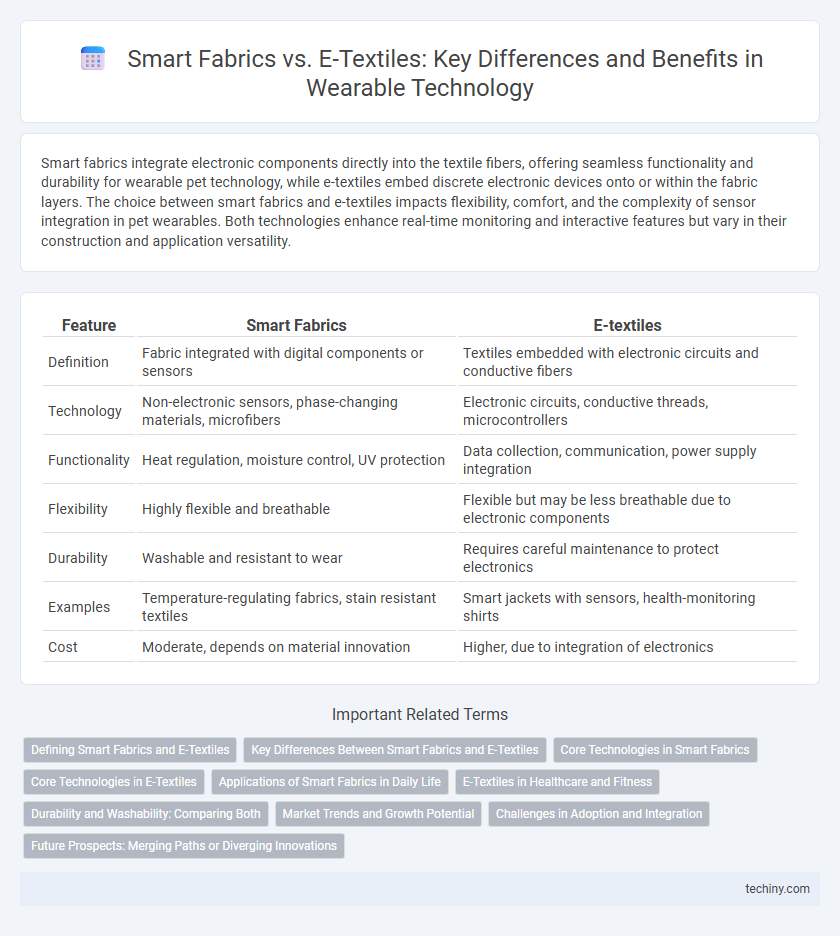Smart fabrics integrate electronic components directly into the textile fibers, offering seamless functionality and durability for wearable pet technology, while e-textiles embed discrete electronic devices onto or within the fabric layers. The choice between smart fabrics and e-textiles impacts flexibility, comfort, and the complexity of sensor integration in pet wearables. Both technologies enhance real-time monitoring and interactive features but vary in their construction and application versatility.
Table of Comparison
| Feature | Smart Fabrics | E-textiles |
|---|---|---|
| Definition | Fabric integrated with digital components or sensors | Textiles embedded with electronic circuits and conductive fibers |
| Technology | Non-electronic sensors, phase-changing materials, microfibers | Electronic circuits, conductive threads, microcontrollers |
| Functionality | Heat regulation, moisture control, UV protection | Data collection, communication, power supply integration |
| Flexibility | Highly flexible and breathable | Flexible but may be less breathable due to electronic components |
| Durability | Washable and resistant to wear | Requires careful maintenance to protect electronics |
| Examples | Temperature-regulating fabrics, stain resistant textiles | Smart jackets with sensors, health-monitoring shirts |
| Cost | Moderate, depends on material innovation | Higher, due to integration of electronics |
Defining Smart Fabrics and E-Textiles
Smart fabrics are textile materials integrated with advanced technologies that enable responsive functions like temperature regulation, moisture management, and shape alteration. E-textiles, a subset of smart fabrics, incorporate embedded electronic components such as sensors, microcontrollers, and conductive fibers to facilitate real-time data collection and communication. Both categories revolutionize wearable technology by merging functionality with comfort, but e-textiles emphasize electronic integration for interactive applications.
Key Differences Between Smart Fabrics and E-Textiles
Smart fabrics integrate advanced materials with embedded capabilities like sensing, heating, or light emission, while e-textiles specifically incorporate electronic components such as conductive fibers and circuits for data transmission. The primary difference lies in smart fabrics' focus on inherent material properties enhancing functionality, whereas e-textiles prioritize electronics integration for connectivity and control. Understanding these distinctions is essential for selecting appropriate wearable technology solutions in healthcare, sports, and fashion industries.
Core Technologies in Smart Fabrics
Smart fabrics leverage advanced materials such as conductive fibers, phase change materials, and nanotechnology to integrate sensory and responsive functions directly into textiles, offering enhanced durability and flexibility. Core technologies include embedded microelectromechanical systems (MEMS), electroactive polymers, and flexible sensors, enabling real-time monitoring and adaptive performance. These innovations distinguish smart fabrics from conventional e-textiles by embedding intelligence at the fiber level rather than adding external electronic components.
Core Technologies in E-Textiles
E-textiles integrate conductive fibers, sensors, and microcontrollers directly into fabrics, enabling seamless data collection and transmission, unlike traditional smart fabrics that primarily embed external devices. Key core technologies in e-textiles include flexible printed circuits, conductive yarns made from silver or carbon-based materials, and stretchable sensors that monitor physiological signals such as heart rate and temperature. These innovations create highly responsive and durable garments, driving advancements in healthcare monitoring, sports performance, and wearable safety applications.
Applications of Smart Fabrics in Daily Life
Smart fabrics, integrated with sensors and conductive fibers, enable real-time health monitoring, temperature regulation, and interactive fashion in daily life. These applications enhance athletic performance, improve medical diagnostics, and provide adaptive clothing that responds to environmental changes. Compared to e-textiles, smart fabrics offer more seamless integration and durability for everyday wear and practical use.
E-Textiles in Healthcare and Fitness
E-textiles embedded with sensors and conductive threads provide real-time monitoring of vital signs, enabling early detection of health issues and continuous fitness tracking. Their integration into healthcare allows improved patient mobility and comfort while collecting accurate biometric data. In fitness, e-textiles enhance performance analysis by tracking muscle exertion and posture without bulkiness or restrictive devices.
Durability and Washability: Comparing Both
Smart fabrics incorporate conductive fibers and are designed for enhanced durability and repeated washing without significant degradation, maintaining their functional properties over time. E-textiles embed electronic components within textile materials, which can be more susceptible to damage from laundering due to the fragility of electronic circuits. Advances in encapsulation and flexible circuitry have improved the washability of e-textiles, but smart fabrics generally offer superior resilience for long-term, everyday use.
Market Trends and Growth Potential
Smart fabrics and e-textiles are revolutionizing the wearable technology market with rapid advancements in materials embedded with sensors and conductive fibers. Market trends indicate a compound annual growth rate (CAGR) of over 25% driven by increasing demand in healthcare, sports, and military applications. Investment in research and development is accelerating the integration of flexible electronics, enhancing the scalability and functionality of smart garments.
Challenges in Adoption and Integration
Smart fabrics face significant challenges in balancing comfort and durability, as embedding sensors and conductive materials often compromises flexibility and washability. E-textiles struggle with seamless integration of electronic components without increasing weight or causing skin irritation, limiting widespread adoption. Battery life, data security, and standardization remain critical barriers to achieving user-friendly, reliable wearable technology in both smart fabrics and e-textiles.
Future Prospects: Merging Paths or Diverging Innovations
Smart fabrics and e-textiles both represent cutting-edge advances in wearable technology with unique potentials; smart fabrics integrate sensors and electronics seamlessly into the fabric fibers, while e-textiles embed electronic components more discretely within textiles. Future prospects indicate a convergence as innovations increasingly incorporate both properties, enabling garments with enhanced functionality such as real-time health monitoring, adaptive climate control, and interactive capabilities. Market forecasts predict a surge in the adoption of hybrid solutions driven by demand for multifunctional, durable, and user-friendly wearable devices across healthcare, sports, and fashion industries.
Smart Fabrics vs E-textiles Infographic

 techiny.com
techiny.com